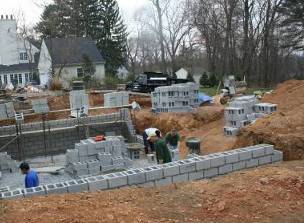- 43 reads

Spend $750 now and
SAVE $300 each year...
ROI = 40%
Highlights
For additions or new home construction, install insulation to the exterior of all basement walls to add at least R-11.
For example, for an addition you can use an unfaced R-11.5 over 8" Concrete Block (CMU) or preferred 12" thick CMU filled with concrete and wood or metal 2x4 studs on the inside with insulation. In addition to energy savings, you will create a room that has a more comfortable climate and you may consider finishing the floors so that it is more than just storage. Select a 'Formaldehyde-Free' insulation to save on air quality and health.
For existing properties, make sure to insulate the space between the top of the basement wall and the underside of the first floor. These 'Basement Rim Joist' cavities between the floor joist bays are very often left without insulation in older homes. The value of this 'infil' insulation comes in preventing the energy loss from the narrow floor thickness band that is just above grade and exposed to the outside air temperatures. If you add the insulation yourself, just make sure to place the foil/vapor barrier on the 'warm side'.
The ROI Calculation is based on saving $15 a month over the course of the year. The price of this option could also be reduced if your improvements qualify for a tax credit.
TAX CREDITS: The American Recovery and Reinvestment Act (ARRA) provides you with a 30% Tax Credit for Insulated Basement Walls that are put into service by the end of 2010. This tax credit item is only for existing homes, not new construction, that is your primary residence and it includes ONLY the cost of materials and NOT installation.
3 KEY POINTS -
- The tax credit cap is $1,500 on collective home improvement elements other than Geo-Thermal 'Ground Source' Heat Pumps, Solar Hot Water Heating, Solar Photovoltaic, and Fuel Cell systems - which each have no cap and are eligible through 2016.
- The tax credits for exterior 'weatherization' improvements like windows, doors and insulation do not include the cost of installation!
- If you reach the $1,500 cap in 2009, you are not eligible for additional tax credits in 2010.
Choose Insulation for Basement Walls that meet these criteria to get the Tax Credit; and check products carefully, because in many cases an ENERGY STAR certification does not necessarily meet the tax credit requirements below:
- Must meet 2009 IECC & Amendments
- For insulation to qualify, its primary purpose must be to insulate (Example: vapor retarders are covered, insulated siding does not qualify).
- Must be expected to last 5 years OR have a 2-year warranty.
- Please note that qualified insulated attic hatch and stair covers will count for the tax credit and they often have a very high return on investment.
- To qualify for the Federal tax credit, homeowners must only meet the level of insulation required for the area they are insulating. For example, a homeowner can choose only to insulate their attic to the levels required in the 2009 IECC and still be eligible for the tax credit. For most homeowners, this will mean adding an additional R-19 to R-30 insulation to their attic. If a homeowner insulates part of their home to a level below the 2009 IECC, this would not qualify.
- Required insulation levels will vary by region and will include insulation that is already installed in your home. For an idea of required Insulation levels, check out this map by the North American Insulation Manufacturers Association.
Good to Know: Properly insulate your house since 40%- 50% of the energy that a single family house consumes goes toward heating and cooling. Across America many of the building codes still require crawl space insulation in the floor joists, when one of the more effective strategies is to insulate the walls with adequate ventilation to prevent moisture build up.
Consider: Radon Testing - Radon can be tested through several methods; Charcoal, Eperm packets, or X-Ray Film. Some of the methods give homeowners the 'score' via email after the packet has been mailed in to the test lab. The cost is about $20.
 Consider using 12” vs. 8” Concrete block that is filled. If possible, excavate to have a ‘walk-out’ basement, and add exterior insulation (yellow panels) that also reduce the hydrostatic pressure that can cause leaky basements.
Consider using 12” vs. 8” Concrete block that is filled. If possible, excavate to have a ‘walk-out’ basement, and add exterior insulation (yellow panels) that also reduce the hydrostatic pressure that can cause leaky basements.


